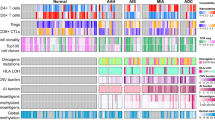Abstract
Background
Regulatory T lymphocytes (Tregs) are known to have host-immune dampening effects in many tumors and to be associated with increased tumor recurrence. Pharmacologic therapies have been developed to target these cells and hence strengthen the host’s immune system. The FoxP3 gene is a marker of Tregs and can be visualized with immunohistochemistry (IHC). We investigated the presence and pattern of Tregs in non-small-cell lung tumors to determine possible therapeutic targets in lung cancer.
Methods
We selected archival samples of primary lung carcinoma and benign inflamed lung from 32 surgical resections. We created a tissue array containing duplicate cores from the N1 and N2 nodal stations from 16 of the cases along with paired benign lung and tumor. We used whole-slide analysis for the other 16 cases. We used FoxP3 IHC to visualize Tregs in all lymphoid tissue present and to assess the quantity and pattern within the tissues.
Results
All lymphoid tissue contains Tregs, but adenocarcinoma had significantly higher levels than both inflammatory lung controls and squamous carcinomas (p ≤ 0.008). Benign N1 lymph nodes (from patients with lung cancer) showed higher numbers of Tregs for adenocarcinoma versus squamous carcinoma.
Conclusions
These findings reveal that Tregs are present in all lung tissues examined, but with significant enrichment in adenocarcinoma. This may lead to a more permissive microenvironment for adenocarcinoma and may explain aggressive patterns of tumor spread for this histology. Lung cancer patients with adenocarcinoma histology may benefit most from Treg-targeted therapy.



Similar content being viewed by others
References
Balkwill F, Mantovani A (2001) Inflammation and cancer: back to Virchow? Lancet 357:539–545
Sakaguchi S, Sakaguchi N, Asano M, Itoh M, Toda M (1995) Immunologic self-tolerance maintained by activated T cells expressing IL-2 receptor alpha-chains (CD25). Breakdown of a single mechanism of self-tolerance causes various autoimmune diseases. J Immunol 155(3):1151–1164
Sutmuller RP, Van Duivenvoorde LM, Van Elsas A et al (2001) Synergism of cytotoxic T lymphocyte-associated antigen 4 blockade and depletion of CD25 regulatory T cells in antitumor therapy reveals alternative pathways for suppression of autoreactive cytotoxic T lymphocyte responses. J Exp Med 194(6):823–832
Fontenot JD, Gavin MA, Rudensky AY (2003) Foxp3 programs the development and function of CD4 CD25 regulatory T cells. Nat Immunol 4(4):330–336
Hori S, Nomura T, Sakaguchi S (2003) Control of regulatory T cell development by the transcription factor Foxp3. Science 299(5609):1057–1061
Wolf D, Wolf AM, Rumpold H et al (2005) The expression of the regulatory T cell-specific forkhead box transcription factor Foxp3 is associated with poor prognosis in ovarian cancer. Clin Cancer Res 11(23):8326–8331
Liyanage UK, Moore TT, Joo HG et al (2002) Prevalence of regulatory T cells is increased in peripheral blood and tumor microenvironment of patients with pancreas or breast adenocarcinoma. J Immunol 169(5):2756–2761
Sasada T, Kimura M, Yoshida Y, Kanai M, Takabayashi A (2003) CD4CD25 regulatory T cells in patients with gastrointestinal malignancies: possible involvement of regulatory T cells in disease progression. Cancer 98(5):1089–1099
Ichihara F, Kono K, Takahashi A, Kawaida H, Sugai H, Fujii H (2003) Increased populations of regulatory T cells in peripheral blood and tumor-infiltrating lymphocytes in patients with gastric and esophageal cancers. Clin Cancer Res 9(12):4404–4408
Halpern AC, Schuchter LM (1997) Prognostic models in melanoma. Semin Oncol 24(1 Suppl 4):S2–S7
Gajewski TF, Meng Y, Blank C et al (2006) Immune resistance orchestrated by the tumor microenvironment. Immunol Rev 213(1):131–145
Petersen RP, Campa MJ, Sperlazza J et al (2006) Tumor infiltrating Foxp3 regulatory T-cells are associated with recurrence in pathologic stage I NSCLC patients. Cancer 107(12):2866–2872
Shimizu K, Nakata M, Hirami Y, Yukawa T, Maeda A, Tanemoto K (2010) Tumor-infiltrating Foxp3+ regulatory t cells are correlated with cyclooxygenase-2 expression and are associated with recurrence in resected non-small cell lung cancer. J Thorac Oncol 5(5):585–590
Lynch TJ, Bondarenko I, Luft A et al (2011) Ipilimumab in combination with paclitaxel and carboplatin as first-line treatment in stage IIIB/IV non-small-cell lung cancer: results from a randomized, double-blind, multicenter phase II study. J Clin Oncol 30(17):2046–2054
Brahmer JR, Horn L, Antonia S et al (2012) Clinical activity and safety of anti-PD1 (BMS-936558, MDX-1106) in patients with advanced non-small-cell lung cancer. J Clin Oncol 30(2 suppl):abstr 7509
Sobin LH, Gospodarowicz MK, Wittekind C (2009) TNM classification of malignant tumors (International Union against Cancer), 7th edn. Wiley-Blackwell, New York, pp 136–146
Huh JW, Lee JH, Kim HR (2012) Prognostic significance of tumor-infiltrating lymphocytes for patients with colorectal cancer. Arch Surg 147(4):366–372
Esendagli G, Bruderek K, Goldmann T et al (2008) Malignant and nonmalignant lung tissue areas are differentially populated by natural killer cells and regulatory T cells in non-small cell lung cancer. Lung Cancer 59(1):32–40
Woo EY, Yeh H, Chu CS et al (2002) Cutting edge: regulatory T cells from lung cancer patients directly inhibit autologous T cell proliferation. J Immunol 168(9):4272–4276
Schneider T, Kimpfler S, Warth A et al (2011) Foxp3+ regulatory T cells and natural killer cells distinctly infiltrate primary tumors and draining lymph nodes in pulmonary adenocarcinoma. J Thorac Oncol 6(3):432–438
Staples CA, Muller NL, Miller RR, Evans KG, Nelems B (1988) Mediastinal nodes in bronchogenic carcinoma: comparison between CT and mediastinoscopy. Radiology 167(2):367–372
Conflict of interest
The authors declare that they have no conflict of interest.
Author information
Authors and Affiliations
Corresponding author
Rights and permissions
About this article
Cite this article
Black, C.C., Turk, M.J., Dragnev, K. et al. Adenocarcinoma Contains More Immune Tolerance Regulatory T-cell Lymphocytes (Versus Squamous Carcinoma) in Non-small-Cell Lung Cancer. Lung 191, 265–270 (2013). https://doi.org/10.1007/s00408-013-9455-7
Received:
Accepted:
Published:
Issue Date:
DOI: https://doi.org/10.1007/s00408-013-9455-7




